
1.
Making a copy of DNA is called _________________________.
2.
Which nitrogen base isn’t used during
3. Name the enzyme you learned about that adds the complementary nucleotides and spell checks to make sure the new copy is correct.
DNA, RNA, & PROTEINS REVIEW
(We did this one in class)
 |
1.
Making a copy of DNA is called _________________________.
2.
Which nitrogen base isn’t used during 3. Name the enzyme you learned about that adds the complementary nucleotides and spell checks to make sure the new copy is correct. |
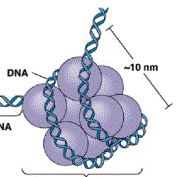 |
4.
The beadlike bundles that form when DNA wraps up are called _________________. 5.
Name the protein in the center of the bundle that DNA wraps around.
Image from:
Biology; Miller and Levine; Pearson Education publishing as Prentice
Hall; 2006
|
|
|
|
 |
8.
USE THE mRNA CODE WHEEL
Image from:
Biology; Miller and Levine; Pearson Education publishing as Prentice Hall; 2006
|
9.
Which kind of RNA has an ANTICODON region and carries the amino acids to the
ribosome?
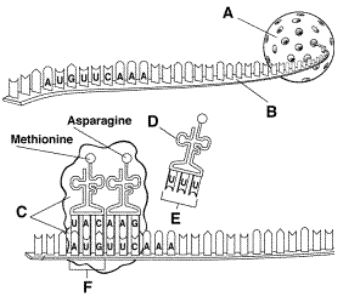 |
10.
B = ? 11.
F = ? 12.
C = ?
|
13.
Tell one way DNA is different from RNA.
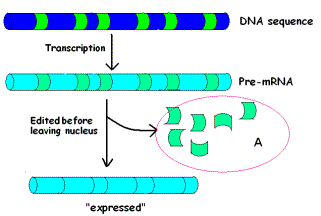 |
14.
What do we call the small pieces of RNA that are edited out of the mRNA message
before it is expressed?
|
16. Tell
what form DNA would be found in during REPLICATION and TRANSCRIPTION.
CHROMOSOMES
CHROMATIN
17.
When making DNA, CYTOSINE always pairs with _______________________.
 |
18.
Using an RNA message to make a protein is called _______________________. |
 |
19.
Name this subunit used to build DNA
and RNA.
|
20.
Name the spot where RNA polymerase attaches to the DNA during TRANSCRIPTION.
21. Give the
complementary DNA strand.
A T T G C C A G C
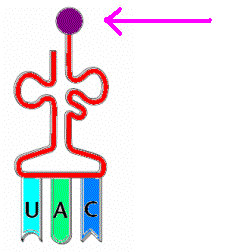 |
22.
NAME THIS KIND OF RNA. 23. Name the molecule attached at the arrow. Image modified from: Biology; Miller and Levine; Pearson Education publishing as Prentice Hall; 2006 |
|
24. What is the type of mutation called where a piece of DNA breaks off, flips, and reattaches so that it reads backwards? A. substitution
B. insertion C. inversion D. translocation
|
25.
PROTEIN SYNTHESIS could also be called ___________________.
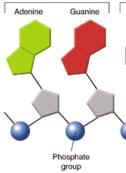 |
26.
Nitrogen bases made up of TWO RINGS are called |
27. What is the name of the mutation which one nucleotide in a code is replaced
by another (A replaces C)
| A. DELETION B. INSERTION C. TRANSLOCATION D. SUBSTITUTION |
|
Image from: http://www.biologyonline.org/2/8_mutations.htm
|
28.
Name this kind of mutation. |
29. TRUE OR FALSE:
ALL MUTATIONS ARE HARMFUL.
|
Image by Riedell |
30.
Name this subunit used to build PROTEINS. |
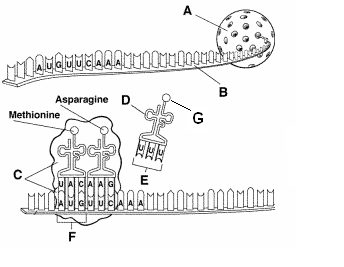
Image
from:
Biology; Miller and Levine; Pearson Education publishing as Prentice Hall; 2006 |
31.
E = ? |
32.
Name the nucleic acid that is double stranded and contains deoxyribose sugar.
33. Name the woman whose X-ray images of DNA helped James Watson and Francis Crick to figure out the structure of DNA.
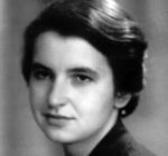
http://en.wikipedia.org/wiki/Rosalind_Franklin |
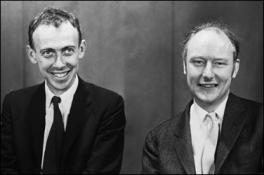
http://www.time.com/time/time100/scientist/profile/watsoncrick.html |
1.replication
2. uracil
3. DNA polymerase
4. nucleosome
5. histone
6. transcription
7. in nucleus
8. serine-lysine-phenylalanine
9. tRNA
10. mRNA
11. codon
12. ribosome
13.
| DNA Double stranded contains deoxyribose sugar A,T,G,C No uracil Carries genetic information Stays in nucleus |
RNA Single stranded contains ribose sugar A,U,G,C No thymine Carries info from DNA to cytoplasm; helps with protein synthesis Made in nucleus; works in cytoplasm |
14. introns
15. exons
16. chromatin
17. guanine
18. translation
19. nucleotide
20. promoter
21. T A A C G G T C G
22. tRNA
23. amino acid
24. C - inversion
25. translation
26. purines
27. D. SUBSTITUTION
28. inversion
29. False; mutations that increase survival and reproduction can be helpful
30. Amino acid
31. anti-codon
32. DNA
33. Rosalind Franklin
34. RNA polymerase